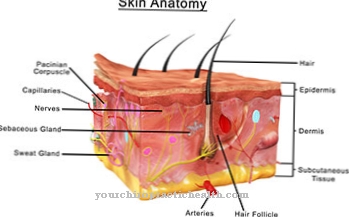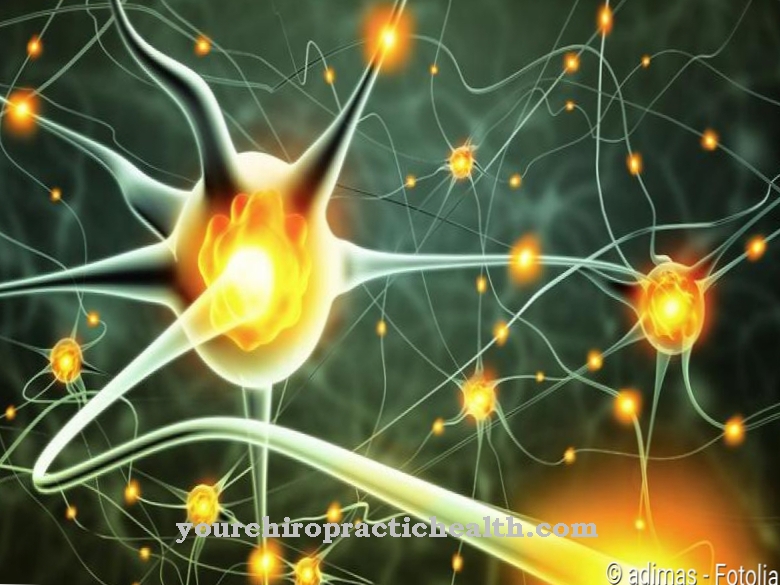The WHIM syndrome stands for warts – hypogammaglobulinemia – immunodeficiency – myelocathexis – syndrome and is an inherited and very rare immune deficiency disease. The disease is based on the so-called cytokine receptor defect, which affects the immune system. The WHIM syndrome is inherited as an autosomal dominant or recessive trait.
What is WHIM Syndrome?
The main feature of the WHIM syndrome is an immune deficiency that is characterized by recurring bacterial and viral infections. The airways are always affected. In the course of the disease, sinus infections, pneumonia and tonsillitis occur here.
If the disease is left untreated, it can lead to serious sequelae. Those affected also often suffer from infections with human papillomaviruses. These cause wart formation, usually on the hands and feet. Furthermore, patients with Whim syndrome are at high risk of developing viral tumors such as cervical cancer.
The blood serum often shows low levels of IgG, which is known as hypogammaglobulinaemia. Histology shows that the bone marrow of those with WHIM syndrome has excessive T-progenitor cells. In contrast, what is known as neutropenia is often the result, which is due to an incorrect release and retention of neutrophils in the bone marrow. This is known as myelocathexis.
causes
The causes of the WHIM syndrome lie in a genetic defect. It is a so-called antibody deficiency syndrome, which can occur sporadically or in families. However, the latter is more likely to be the case. and occurs in about half of those affected. There is almost always an autosomal dominant or recessive inheritance pattern in the genetic make-up.
In most cases, the disease is passed on from one generation to the next, with the distribution across the sexes being mostly even. This is why we speak of an autosomal dominant inheritance. Various studies in twins have shown that siblings are as concordant as they are discordant for the occurrence of WHIM syndrome.
According to current knowledge, a possible cause for the WHIM syndrome is also various environmental influences or epigenetic factors, if a predisposing gene is also present as a trigger for the WHIM syndrome.
Symptoms, ailments & signs
The WHIM syndrome is an autosomal dominant hereditary disease. The cause of this is a mutation of the gene on the gene locus 2q21 in over 90 percent of those affected. This is responsible for deciphering the so-called chemokine receptor CXCR4.
The mutation, which can be found in the intracellular area of the membrane-bound receptor for the cytokine CXCL12, causes the appearance of a shortened receptor protein. This is not able to internalize itself after activation. In this way, all mechanisms that cause negative self-regulation are permanently blocked.
The receptors are thus permanently stimulated. The reduced expression of the CXCR4 is also required for the release of the T precursor cells of the bone marrow. The mutations and the lack of internalization of the CXCR4 remain superficially on the TZ precursor cells. Therefore, they are unable to leave the bone marrow.
They are therefore the cause of histological findings in the patient's blood and bone marrow. The WHIM syndrome can also occur in rare cases with a non-mutated chemokine receptor. This is usually based on a malfunction of the proteins that are involved in the internalization of the CXCR4.
Here, too, a disturbed immune defense occurs because the CXCR4 receptor is also involved in other migration processes. The sometimes greatly reduced immune defense of those affected is the main feature of the WHIM syndrome.
Diagnosis & course of disease
If the WHIM syndrome is proven, an exact medical history should be taken to rule out a drug-induced disease. This can occur, for example, after the administration of antibiotics. If the WHIM syndrome is isolated without any clinically detectable symptoms, regular blood counts including a differential blood count and clinical examinations should be carried out.
In some cases a spontaneous remission of the disease could also be observed, which occurred after about five to six weeks. Most of the time, the WHIM syndrome is chronic. Thanks to modern genetic research, it is now possible to identify most hereditary diseases before they break out. However, since the genetic information is very different for each person, the genetic analyzes are still very imprecise.
Complications
THE WHIM syndrome is associated with a number of complaints and complications. Typical sequelae include warts and respiratory infections. Warts, in particular, can cause psychological complaints in those affected, because the cosmetic blemish represents a considerable emotional burden.
People who suffer from WHIM syndrome therefore often develop mental illnesses, such as social anxiety, depression or inferiority complexes. Furthermore, pneumonia can occur as part of the disease. If pneumonia is not treated promptly, serious complications such as high fever, shortness of breath, and cyanosis can occur. In the worst case, the pneumonia is fatal. WHIM syndrome can also cause infections in the ear and nasopharynx.
In the later stages of the disease, due to the weakened immune system, sinusitis, otitis and other infectious diseases develop, each of which is associated with serious complications. Treatment of wart-hypogammaglobulinaemia-immunodeficiency-myelocathexis syndrome is mostly uneventful.
However, the use of immunoglobulins can lead to undesirable side effects and interactions. Allergic reactions rarely occur. Anaphylactic shock or severe circulatory reactions occur very rarely. Inadvertent administration into the veins can cause tissue damage and circulatory problems.
When should you go to the doctor?
The affected person should always contact a doctor with WHIM syndrome, as self-healing cannot occur and the symptoms continue to worsen if a doctor is not consulted. Early detection and treatment of the disease has a very positive effect on the further course. Since this is a genetic disease, a complete cure cannot be achieved. However, if you want to have children, you should also consult a doctor for genetic counseling.
In the case of WHIM syndrome, a doctor should still be consulted if the person concerned has a very weak immune system and is very often ill as a result. In the process, warts often form all over the body and the person affected repeatedly suffers from inflammation of the lungs or tonsils. If these symptoms appear over a longer period of time and do not go away on their own, a doctor should always be consulted.The diagnosis of WHIM syndrome can be made by a general practitioner. Further treatment depends on the exact complaints and their severity.
Treatment & Therapy
The common therapy of the patients affected by the WHIM syndrome consists in the endeavor to reduce the susceptibility to infections, since this is the main problem of the disease. Substitutions with immunoglobulins are often used to support the immune system of those affected.
It is also necessary to normalize the release of neutrophils from the bone marrow. So that this can be achieved, GM-CSF or G-CSF is mostly used. The use of the so-called CXCR4 antagonists, including Plerixafor, is already being analyzed in multiple clinical studies. However, it is not yet part of the standard therapy for WHIM syndrome. Lifelong medication is indicated to treat the disease, as the genetic defect cannot be cured.
You can find your medication here
➔ Medicines to strengthen the defense and immune systemprevention
Since the so-called WHIM syndrome is a genetic disease, it cannot be cured. For this reason, prevention is also not possible. It is an autosomal dominant hereditary disease. Gene mutations and a lack of internalization of the CXCR4 remain on the surfaces of the TZ precursor cells. As a result, these cannot escape from the bone marrow and are the cause of histological blood and bone marrow findings. The WHIM syndrome cannot therefore be prevented.
Aftercare
Those affected with WHIM syndrome usually have only limited and only a few direct follow-up measures available. For this reason, those affected with this disease should ideally consult a doctor very early and initiate treatment so that there are no complications or other complaints in the further course. Self-healing cannot occur.
Since the WHIM syndrome is a hereditary disease, genetic testing and counseling should definitely be carried out if the child wishes to have children so that the syndrome cannot recur in the children. With WHIM syndrome, those affected are usually dependent on the intake of various medications.
Attention should always be paid to the correct dosage and regular intake, whereby a doctor should always be contacted first if there are any questions or uncertainties. In many cases the help and support of one's own family is also very important.
This can prevent or limit depression. In some cases, contact with other people affected by WHIM syndrome can be useful and make everyday life easier for the person affected. The syndrome can significantly reduce the life expectancy of those affected.
You can do that yourself
People suffering from WHIM syndrome suffer from an immune deficiency. For this reason, everything should be done lifelong to support and stabilize the immune system as best as possible. A balanced and healthy diet is particularly important. A diet rich in vitamins helps to reduce susceptibility to pathogens.
At the same time, it is important to ensure that the consumption of harmful substances nicotine or drugs is completely avoided. The ambient air should always be rich in oxygen to prevent breathing disorders. Regular sufficient exercise outdoors is therefore highly recommended. As soon as there is a shortage of breath, the person affected should leave the area or seek a doctor's advice. Particular attention should be paid to wearing warm clothing during the change of seasons. Temperatures are often underestimated, which increases the risk of a cold.
Direct physical contact with other people suffering from an infection or a cold should be avoided. We recommend that you always carry disinfectants for your hands or feet with you. This can be used preventively when people are in the immediate vicinity who are showing the first symptoms of a cold. In public facilities it is also important to ensure that areas in which there are many germs are avoided. It is advisable to wear appropriate protective clothing.

.jpg)
.jpg)
.jpg)























